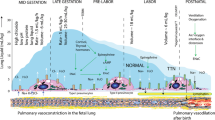Abstract
Cardiac abnormalities in birth asphyxia were first recognised in the 1970s. These include (i) transient tricuspid regurgitation which is the commonest cause of a systolic murmur in a newborn and tends to disappear without any treatment unless it is associated with transient myocardial ischemia or primary pulmonary hypertension of the newborn (ii) transient mitral regurgitation which is much less common and is often a part of transient myocardial ischemia, at times with reduced left ventricular function and, therefore, requires treatment in the form of inotropic and ventilatory support (iii) transient myocardial ischemia (TMI) of the newborn. This should be suspected in any baby with asphyxia, respiratory distress and poor pulses, especially if a murmur is audible. It is of five types (A to E) according to Rowe’s classification. Type B is the most severe with respiratory distress, congestive heart failure and shock. Echocardiography helps to rule out critical left ventricular obstructive lesions like hypoplastic left heart syndrome or critical aortic stenosis. ECG is very important for diagnosis of TMI, and may show changes ranging from T wave inversion in one lead to a classical segmental infarction pattern with abnormal q waves. CPK-MB may rise and echocardiogram shows impaired left ventricular function, mitral and/or tricuspid regurgitation, and at times, wall motion abnormalities of left ventricle. Ejection fraction is often depressed and is a useful marker of severity and prognosis. Treatment includes fluid restriction, inotropic support, diuretics and ventilatory resistance if required (v) persistent pulmonary hypertension of the newborn (PPHN). Persistent hypoxia sometimes results in persistence of constricted fetal pulmonary vascular bed causing pulmonary arterial hypertension with consequent right to left shunt across patent ductus arteriosus and foramen ovale. This causes respiratory tension and right ventricular failure with systolic murmur of tricuspid, and at times, mitral regurgitation. Treatment consists of oxygen and general care for mild cases, ventilatory support, ECMO and nitric oxide for severe cases.
Cardiac abnormalities in asphyxiated neonates are often underdiagnosed and require a high index of suspicion. ECG and Echo help in early recognition and hence better management of these cases.
Similar content being viewed by others
References
Rowe RD, Izukawa T, Mulholland HC, Bloom KR, Cook DH, Swyer PR. Nonstructural heart disease in the newborn. Observation during one year in a perinatal service.Arch Dis Child 1978; 53(9): 726–730.
Rowe RD, Finley JP, Gilday DLet al. Myocardial ischaemia in the newborn in Paediatric Cardiology 1980.
Cabal LA, Devaskar U, Siassi B, Hodgman Je, Emmanouilides G. Cardiogenic shock associated with perinatal asphyxia in pretern infants.J Pediatr 1980; 96(4):704–710.
Martin Ancel A, Garcia-Alix A, Gaya F, Cabanas F, Burgueros M, Quero J. Multiple organ involvement in perinatal asphyxia.J Pediatr 1995; 127(5): 786–793.
Primhak RA, Jedeikin R, Ellis Get al. Myocardial ischaemia in asphyxia neonatorum. Electrocardiographic, enzymatic and histologic correlations.Acta Paediatr Scand 1985; 74(4):595–600.
Finley JP, Howman-Giles RB, Gilday DL, Bloom KR, Rowe RD. Transient myocardial ischaemia of the newborn infant demonstrated by thallium myocardial imaging.J Pediatr 1979; 94(2): 263–270.
Turner-Gomez SO, Izukawa T, Rowe RD. Persistence of atrioventricular valve regurgitation and elctrocardiographic abnormalities following transient myocardial ischaemia of the newborn.Pediatr Cardiol 1989; 10(4): 191–194.
Donnelly WH, Bucciarelli RL, Nelson RM. Ischaemic papillary muscle necrosis in stresses newborn infants.J Pediatr 1980; 96(2): 295–300.
Flores-Nava G, Echevarria-Ybarguengoitia JL, Navarro-Barron JL, Garcia-Alonso A. Transient myocardial ischaemia in newborn babies with perinatal asphyxia.Bol Med Hosp Infant Mex 1990; 47(12):809–814.
Farru O, Rizzardini M, Guzman N. Transient myocardiac ischaemia of the newborn infants.Arch Mal Coeur Vaiss 1986; 79(5): 633–638.
Davidson D, Barefield ES, Kattwinkel Jet al. Inhaled nitric oxide for the early treatment of persistent pulmonary hypertension of the newborn: A randomised, double masked, placebo controlled, dose response, multicenter study. The I-NO/PPHN study group.Pediatrics 1998; 101:325–334.
Author information
Authors and Affiliations
Rights and permissions
About this article
Cite this article
Ranjit, M.S. Cardiac abnormalities in birth asphyxia. Indian J Pediatr 67, 529–532 (2000). https://doi.org/10.1007/BF02760486
Issue Date:
DOI: https://doi.org/10.1007/BF02760486




